Презентация first aid 1

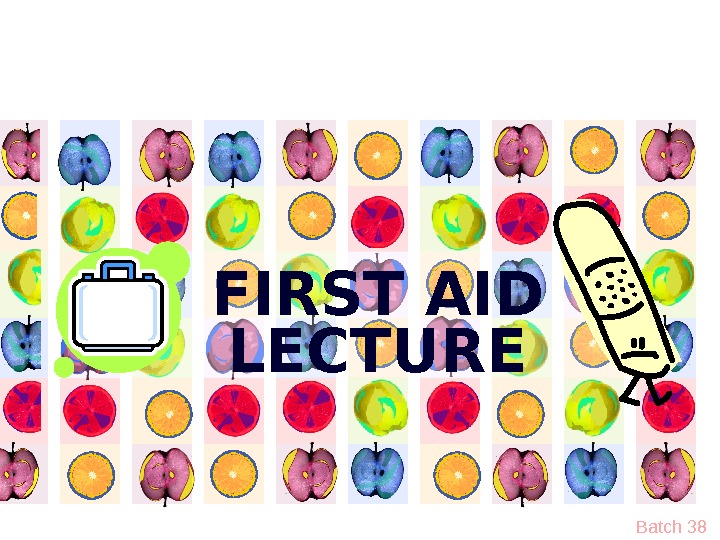











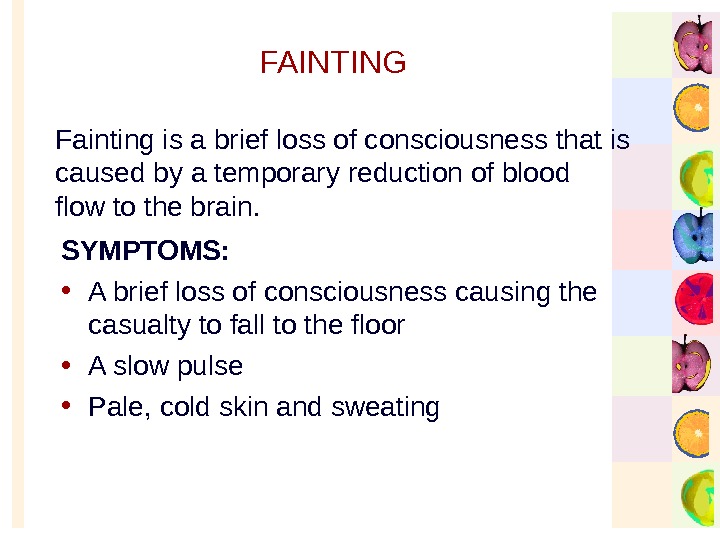













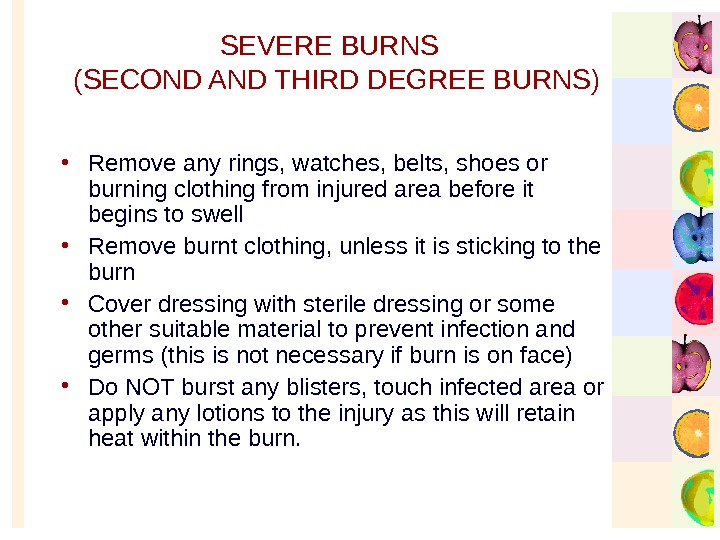

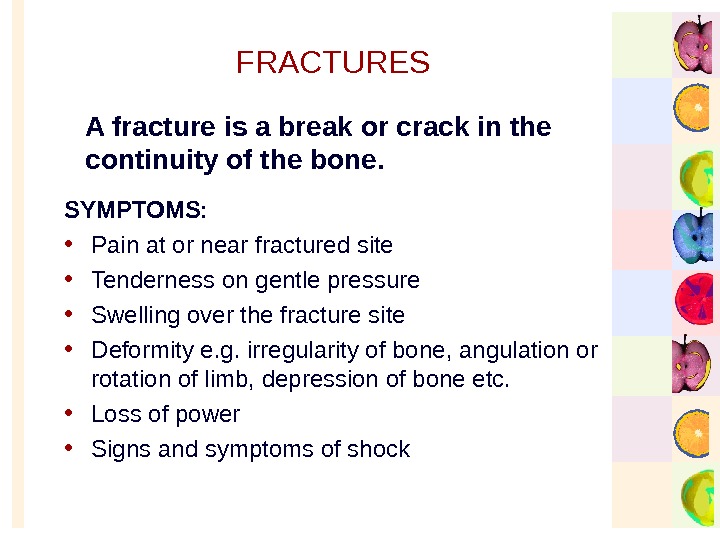




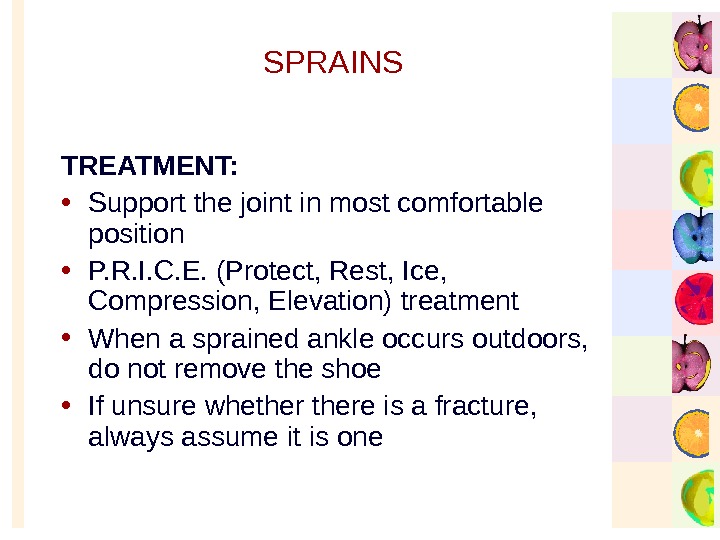



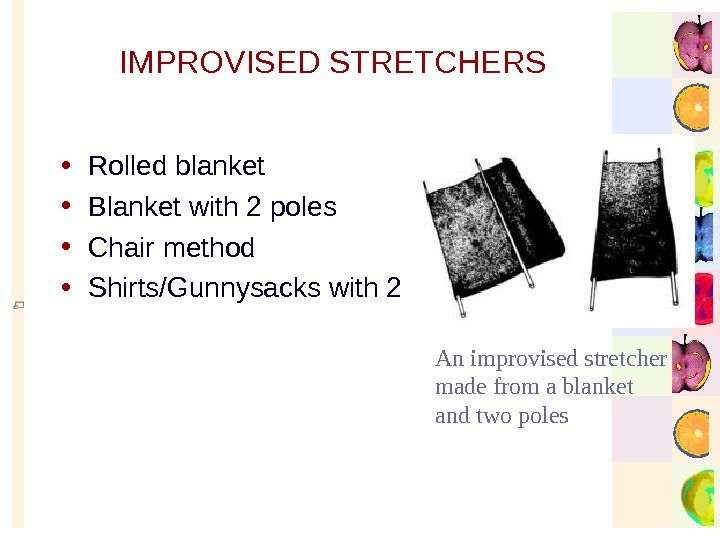
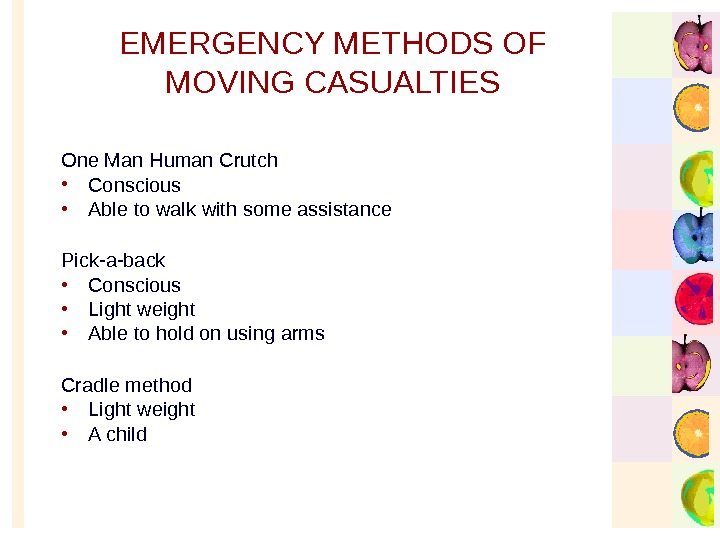






- Размер: 448.5 Кб
- Количество слайдов: 45
Описание презентации Презентация first aid 1 по слайдам
 FIRST AID LECTURE Batch
FIRST AID LECTURE Batch
 DEFINITION OF FIRST AID First Aid is the initial assistance or treatment given to a casualty for any injury or sudden illness before the arrival of an ambulance, doctor, or other qualified personnel.
DEFINITION OF FIRST AID First Aid is the initial assistance or treatment given to a casualty for any injury or sudden illness before the arrival of an ambulance, doctor, or other qualified personnel.
 AIMS OF FIRST AID • Preserve life • Prevent the casualty’s condition from becoming worse • Promote recovery
AIMS OF FIRST AID • Preserve life • Prevent the casualty’s condition from becoming worse • Promote recovery
 RESPONSIBILITIES AS A FIRST AIDER • Assess the situation quickly and safely and summon appropriate help • Protect casualties and others at the scene from possible danger • To identify, as far as possible, the nature of illness or injury affecting casualty. • To give each casualty early and appropriate treatment, treating the most serious condition first.
RESPONSIBILITIES AS A FIRST AIDER • Assess the situation quickly and safely and summon appropriate help • Protect casualties and others at the scene from possible danger • To identify, as far as possible, the nature of illness or injury affecting casualty. • To give each casualty early and appropriate treatment, treating the most serious condition first.
 RESPONSIBILITIES OF A FIRST AIDER • To arrange for the casualty’s removal to hospital or into the care of a doctor. • To remain with a casualty until appropriate care is available. • To report your observations to those taking care of the casualty, and to give further assistance if required.
RESPONSIBILITIES OF A FIRST AIDER • To arrange for the casualty’s removal to hospital or into the care of a doctor. • To remain with a casualty until appropriate care is available. • To report your observations to those taking care of the casualty, and to give further assistance if required.
 PRIORITY OF CASUALTIES • Save the conscious casualties before the unconscious ones as they have a higher chance of recovery. • Save the young before the old. • Do not jeopardize your own life while rendering First Aid. In the event of immediate danger, get out of site immediately. • Remember: One of your aims is to preserve life, and not endanger your own in the process of rendering First Aid.
PRIORITY OF CASUALTIES • Save the conscious casualties before the unconscious ones as they have a higher chance of recovery. • Save the young before the old. • Do not jeopardize your own life while rendering First Aid. In the event of immediate danger, get out of site immediately. • Remember: One of your aims is to preserve life, and not endanger your own in the process of rendering First Aid.
 • Casualties should always be treated in the order of priority, usually given by the “ 3 Bs”: – Breathing – Bleeding – Bones
• Casualties should always be treated in the order of priority, usually given by the “ 3 Bs”: – Breathing – Bleeding – Bones
 RECOVERY POSITION • For people who are unconscious, or semiconscious, but are still breathing. • If there are spinal or neck injuries, do not attempt to place the casualty in the recovery position. • NOTE: Leaving the victim in this position for long periods may cause them to experience nerve compression.
RECOVERY POSITION • For people who are unconscious, or semiconscious, but are still breathing. • If there are spinal or neck injuries, do not attempt to place the casualty in the recovery position. • NOTE: Leaving the victim in this position for long periods may cause them to experience nerve compression.
 STEP 1: Kneel next to the person. Place the arm closest to you straight out from the body. Position the far arm with the back of the hand against the near cheek. STEP 2: Grab and bend the person’s far knee. http: //www. health. harvard. edu/fhg/firstaid/recovery. shtml
STEP 1: Kneel next to the person. Place the arm closest to you straight out from the body. Position the far arm with the back of the hand against the near cheek. STEP 2: Grab and bend the person’s far knee. http: //www. health. harvard. edu/fhg/firstaid/recovery. shtml
 STEP 3: Protecting the head with one hand, gently roll the person toward you by pulling the far knee over and to the ground. STEP 4: Tilt the head up slightly so that the airway is open. Make sure that the hand is under the cheek. Place a blanket or coat over the person (unless he/she has a heat illness or fever) and stay close until help arrives. http: //www. health. harvard. edu/fhg/firstaid/recovery. shtml
STEP 3: Protecting the head with one hand, gently roll the person toward you by pulling the far knee over and to the ground. STEP 4: Tilt the head up slightly so that the airway is open. Make sure that the hand is under the cheek. Place a blanket or coat over the person (unless he/she has a heat illness or fever) and stay close until help arrives. http: //www. health. harvard. edu/fhg/firstaid/recovery. shtml
 HYPERVENTILATION SYMPTOMS: • Unnaturally fast, deep breathing • Attention-seeking behaviors • Dizziness, faintness, trembling, or marked tingling in hands, feet and lips • Headache • Chest pain • Slurred speech • Cramps in the hands and feet. Hyperventilation, also known as excessive breathing, causes a reduction of carbon dioxide concentration (below normal) of the blood.
HYPERVENTILATION SYMPTOMS: • Unnaturally fast, deep breathing • Attention-seeking behaviors • Dizziness, faintness, trembling, or marked tingling in hands, feet and lips • Headache • Chest pain • Slurred speech • Cramps in the hands and feet. Hyperventilation, also known as excessive breathing, causes a reduction of carbon dioxide concentration (below normal) of the blood.
 HYPERVENTILATION CAUSES: • Stress or anxiety • Consequence of lung diseases, head injuries or stroke TREATMENT: • When speaking to casualty, be firm but kind • If possible, lead the casualty to a quiet place where he may be better able to regain control of his breathing • Let him re-breathe his own exhaled air from a paper bag. • (Paper bag is preferred over plastic bag as plastic bag may cause the casualty to suffocate)
HYPERVENTILATION CAUSES: • Stress or anxiety • Consequence of lung diseases, head injuries or stroke TREATMENT: • When speaking to casualty, be firm but kind • If possible, lead the casualty to a quiet place where he may be better able to regain control of his breathing • Let him re-breathe his own exhaled air from a paper bag. • (Paper bag is preferred over plastic bag as plastic bag may cause the casualty to suffocate)
 FAINTING SYMPTOMS: • A brief loss of consciousness causing the casualty to fall to the floor • A slow pulse • Pale, cold skin and sweating. Fainting is a brief loss of consciousness that is caused by a temporary reduction of blood flow to the brain.
FAINTING SYMPTOMS: • A brief loss of consciousness causing the casualty to fall to the floor • A slow pulse • Pale, cold skin and sweating. Fainting is a brief loss of consciousness that is caused by a temporary reduction of blood flow to the brain.
 FAINTING CAUSES: • Taking in too little food and fluids (dehydration) • Low blood pressure • Lack of sleep • Over exhaustion TREATMENT: • Lay casualty down, and slightly elevate legs • Make sure she has plenty of fresh air • As she recovers, reassure her and help her sit up gradually • Look for and treat any injury that has been sustained through falling
FAINTING CAUSES: • Taking in too little food and fluids (dehydration) • Low blood pressure • Lack of sleep • Over exhaustion TREATMENT: • Lay casualty down, and slightly elevate legs • Make sure she has plenty of fresh air • As she recovers, reassure her and help her sit up gradually • Look for and treat any injury that has been sustained through falling
 Shock occurs when the circulatory system fails, and insufficient oxygen reaches the tissues. If the condition is not treated quickly, vital organs can fail, ultimately causing death. Shock is made worse by fear and pain. SYMPTOMS: • Clammy skin (cool, pale and damp) • Restlessness and nervousness • Thirst • Loss of blood • Confusion • Fast breathing • Nausea or vomiting • Blotched or bluish skin (especially around the mouth and lips) • Often perspires freely • May pass out.
Shock occurs when the circulatory system fails, and insufficient oxygen reaches the tissues. If the condition is not treated quickly, vital organs can fail, ultimately causing death. Shock is made worse by fear and pain. SYMPTOMS: • Clammy skin (cool, pale and damp) • Restlessness and nervousness • Thirst • Loss of blood • Confusion • Fast breathing • Nausea or vomiting • Blotched or bluish skin (especially around the mouth and lips) • Often perspires freely • May pass out.
 Shock CAUSES: Shock can be divided into 4 types: • Hypovolemic shock – caused by the loss of blood volume (such as through bleeding) or profound dehydration • Cardiogenic shock – a result of a weakened heart that is unable to pump blood as efficiently as it once did. Commonly occurs after a massive heart attack • Distributive shock – a result of the lack of distribution of blood to the organs • Obstructive shock – results from an obstruction to blood flow at a site other than the heart
Shock CAUSES: Shock can be divided into 4 types: • Hypovolemic shock – caused by the loss of blood volume (such as through bleeding) or profound dehydration • Cardiogenic shock – a result of a weakened heart that is unable to pump blood as efficiently as it once did. Commonly occurs after a massive heart attack • Distributive shock – a result of the lack of distribution of blood to the organs • Obstructive shock – results from an obstruction to blood flow at a site other than the heart
 Shock TREATMENT: • “ P. E. L. C. R. N. ” (Pronounced Pell-Crin) • Position the casualty on their back • Elevate the Legs • Loosen clothing at neck waist or wherever it is binding • Climatize (prevent too hot or too cold) • Reassure (keep the casualty calm) • Notify medical personnel (Help, Get a medic!!)
Shock TREATMENT: • “ P. E. L. C. R. N. ” (Pronounced Pell-Crin) • Position the casualty on their back • Elevate the Legs • Loosen clothing at neck waist or wherever it is binding • Climatize (prevent too hot or too cold) • Reassure (keep the casualty calm) • Notify medical personnel (Help, Get a medic!!)
 BEE/HORNET STING SYMPTOMS: • Redness and swelling in injured area TREATMENT: • Remove stinger as fast as possible • Reduce pain and swelling with cold compress
BEE/HORNET STING SYMPTOMS: • Redness and swelling in injured area TREATMENT: • Remove stinger as fast as possible • Reduce pain and swelling with cold compress
 CRAMPS Cramps are painful sensations caused by contraction or over shortening, usually of muscles. CAUSES: • Cold or overexertion TREATMENT: • Stretch the muscle and apply heat or cold (preferably heat) • Cramps from lack of salt and water: Stretch the muscle, drink water and increase salt intake
CRAMPS Cramps are painful sensations caused by contraction or over shortening, usually of muscles. CAUSES: • Cold or overexertion TREATMENT: • Stretch the muscle and apply heat or cold (preferably heat) • Cramps from lack of salt and water: Stretch the muscle, drink water and increase salt intake
 Choking is the mechanical obstruction of the flow of air from the environment into the lungs. CAUSES: • Introduction of foreign object into airway, which becomes stuck • Respiratory diseases • Compression of airway (e. g. Strangling) CHOKING
Choking is the mechanical obstruction of the flow of air from the environment into the lungs. CAUSES: • Introduction of foreign object into airway, which becomes stuck • Respiratory diseases • Compression of airway (e. g. Strangling) CHOKING
 CHOKING SYMPTOMS: • Unable to speak or cry out • Face turns blue from lack of oxygen • Victim grabbing at his/her throat • Weak coughing, laboured breathing produces high-pitched noise • Unconsciousness TREATMENT: • Encourage victim to cough • Back slaps: Use of hard blows with heel of the hand on the upper back of the victim • Abdominal thrusts: Standing behind the victim and using hands to exert pressure on bottom of the diaphragm (May result in injuries like bruises or fracture of ribs)
CHOKING SYMPTOMS: • Unable to speak or cry out • Face turns blue from lack of oxygen • Victim grabbing at his/her throat • Weak coughing, laboured breathing produces high-pitched noise • Unconsciousness TREATMENT: • Encourage victim to cough • Back slaps: Use of hard blows with heel of the hand on the upper back of the victim • Abdominal thrusts: Standing behind the victim and using hands to exert pressure on bottom of the diaphragm (May result in injuries like bruises or fracture of ribs)
 TYPES OF BURNS Dry burn • Caused by flame, contact with hot objects, friction etc. Scalds • Contact with steam and hot fluids Electrical burn • Low-voltage current, lightning strike Cold injury • Contact with freezing metals, dry ice, freezing vapours e. g. liquid oxygen and liquid nitrogen
TYPES OF BURNS Dry burn • Caused by flame, contact with hot objects, friction etc. Scalds • Contact with steam and hot fluids Electrical burn • Low-voltage current, lightning strike Cold injury • Contact with freezing metals, dry ice, freezing vapours e. g. liquid oxygen and liquid nitrogen
 TYPES OF BURNS Chemical burn • Industrial chemicals, including inhaled fumes and corrosive gases. • Household chemicals, including paint remover, strong acid and alkali, bleach, weed killers etc. Radiation burn • Sunburn over-exposure to ultra-violet (UV) lamp and exposure to radioactive source.
TYPES OF BURNS Chemical burn • Industrial chemicals, including inhaled fumes and corrosive gases. • Household chemicals, including paint remover, strong acid and alkali, bleach, weed killers etc. Radiation burn • Sunburn over-exposure to ultra-violet (UV) lamp and exposure to radioactive source.
 DEGREE OF BURN First degree burn: • This involves only the outermost layer of skin and is characterized by redness, swelling and tenderness. Second degree burn: • Any 1% burn affecting layers of the epidermis, giving rise to rawness, blisters and the presence of a clear fluid. Can be fatal if it affects over 60% of the body. Third degree burn: • All the layers of the skin are burned and there maybe be some damage to the nerves, fat tissue and muscles. Skin may look waxy, pale or charred. Purple fluid is observed and no pain is felt by casualty. Urgent medical attention is required.
DEGREE OF BURN First degree burn: • This involves only the outermost layer of skin and is characterized by redness, swelling and tenderness. Second degree burn: • Any 1% burn affecting layers of the epidermis, giving rise to rawness, blisters and the presence of a clear fluid. Can be fatal if it affects over 60% of the body. Third degree burn: • All the layers of the skin are burned and there maybe be some damage to the nerves, fat tissue and muscles. Skin may look waxy, pale or charred. Purple fluid is observed and no pain is felt by casualty. Urgent medical attention is required.
 MINOR BURNS (FIRST DEGREE BURNS) TREATMENT: • Rinse the injured part with cold water for at least 10 minutes to stop burning and relieve pain • Gently remove any jewelry, watches, belts or constricting clothing from injured area before it begins to swell • Cover area with sterile dressing, or any clean, non-fluffy material and bandage loosely in place. • NOTE: Cold burns should not be rinsed with cold water and cold water should never be applied to anyone with extensive burns.
MINOR BURNS (FIRST DEGREE BURNS) TREATMENT: • Rinse the injured part with cold water for at least 10 minutes to stop burning and relieve pain • Gently remove any jewelry, watches, belts or constricting clothing from injured area before it begins to swell • Cover area with sterile dressing, or any clean, non-fluffy material and bandage loosely in place. • NOTE: Cold burns should not be rinsed with cold water and cold water should never be applied to anyone with extensive burns.
 SEVERE BURNS (SECOND AND THIRD DEGREE BURNS) TREATMENT: • Lay the casualty down and protect the burnt area from contact with the ground if possible • Rinse burn with plenty of cold water for at least 10 minutes or use burn-cooling gel • Arrange for casualty to be sent to the hospital • While cooling the burn, watch for signs of difficulty in breathing and be ready to resuscitate if necessary
SEVERE BURNS (SECOND AND THIRD DEGREE BURNS) TREATMENT: • Lay the casualty down and protect the burnt area from contact with the ground if possible • Rinse burn with plenty of cold water for at least 10 minutes or use burn-cooling gel • Arrange for casualty to be sent to the hospital • While cooling the burn, watch for signs of difficulty in breathing and be ready to resuscitate if necessary
 SEVERE BURNS (SECOND AND THIRD DEGREE BURNS) • Remove any rings, watches, belts, shoes or burning clothing from injured area before it begins to swell • Remove burnt clothing, unless it is sticking to the burn • Cover dressing with sterile dressing or some other suitable material to prevent infection and germs (this is not necessary if burn is on face) • Do NOT burst any blisters, touch infected area or apply any lotions to the injury as this will retain heat within the burn.
SEVERE BURNS (SECOND AND THIRD DEGREE BURNS) • Remove any rings, watches, belts, shoes or burning clothing from injured area before it begins to swell • Remove burnt clothing, unless it is sticking to the burn • Cover dressing with sterile dressing or some other suitable material to prevent infection and germs (this is not necessary if burn is on face) • Do NOT burst any blisters, touch infected area or apply any lotions to the injury as this will retain heat within the burn.
 ELECTRIC SHOCKS (LOW-VOLTAGE CURRENTS) • Break contact of electric source with casualty by switching off mains or meter point (Only if it is safe for you to do so) • If unable to reach cable, stand on insulating material e. g. plastic mat, wooden box and push casualty’s limbs away from source with a broom or stick • Do not touch the person until the power supply is turned off • Be careful in areas that are wet • Dial 995 to summon an ambulance
ELECTRIC SHOCKS (LOW-VOLTAGE CURRENTS) • Break contact of electric source with casualty by switching off mains or meter point (Only if it is safe for you to do so) • If unable to reach cable, stand on insulating material e. g. plastic mat, wooden box and push casualty’s limbs away from source with a broom or stick • Do not touch the person until the power supply is turned off • Be careful in areas that are wet • Dial 995 to summon an ambulance
 FRACTURES SYMPTOMS: • Pain at or near fractured site • Tenderness on gentle pressure • Swelling over the fracture site • Deformity e. g. irregularity of bone, angulation or rotation of limb, depression of bone etc. • Loss of power • Signs and symptoms of shock. A fracture is a break or crack in the continuity of the bone.
FRACTURES SYMPTOMS: • Pain at or near fractured site • Tenderness on gentle pressure • Swelling over the fracture site • Deformity e. g. irregularity of bone, angulation or rotation of limb, depression of bone etc. • Loss of power • Signs and symptoms of shock. A fracture is a break or crack in the continuity of the bone.
 DISLOCATIONS SYMPTOMS: • Pain at the site of injury • Limited movement at joint • Deformity • Swelling • Tenderness. A dislocation is the displacement of one or more bones at a joint. It usually occurs in the shoulders, elbow, thumb, fingers and the lower jaw.
DISLOCATIONS SYMPTOMS: • Pain at the site of injury • Limited movement at joint • Deformity • Swelling • Tenderness. A dislocation is the displacement of one or more bones at a joint. It usually occurs in the shoulders, elbow, thumb, fingers and the lower jaw.
 FRACTURES AND DISLOCATIONS TREATMENT: • Support and immobilize the injured limb • Use a splint (if possible) in order to prevent movement of the injured part • Arrange for casualty to be removed to hospital • In doubtful cases, always treat as for a fracture • Do not attempt to replace the bones
FRACTURES AND DISLOCATIONS TREATMENT: • Support and immobilize the injured limb • Use a splint (if possible) in order to prevent movement of the injured part • Arrange for casualty to be removed to hospital • In doubtful cases, always treat as for a fracture • Do not attempt to replace the bones
 STRAINS SYMPTOMS: • Localised pain • Stiffness • Inflammation • Bruising. A strain is an injury to a muscle in which the Muscle fibres tear as a result of overstretching. (Sprain – to a ligament)
STRAINS SYMPTOMS: • Localised pain • Stiffness • Inflammation • Bruising. A strain is an injury to a muscle in which the Muscle fibres tear as a result of overstretching. (Sprain – to a ligament)
 SPRAINS SYMPTOMS: • Pain at site of of injury • Swelling and later bruising • Pain on movement • Loss of function. A sprain occurs at a joint where there is tearing or over-stretching of the ligaments and tissues.
SPRAINS SYMPTOMS: • Pain at site of of injury • Swelling and later bruising • Pain on movement • Loss of function. A sprain occurs at a joint where there is tearing or over-stretching of the ligaments and tissues.
 SPRAINS TREATMENT: • Support the joint in most comfortable position • P. R. I. C. E. (Protect, Rest, Ice, Compression, Elevation) treatment • When a sprained ankle occurs outdoors, do not remove the shoe • If unsure whethere is a fracture, always assume it is one
SPRAINS TREATMENT: • Support the joint in most comfortable position • P. R. I. C. E. (Protect, Rest, Ice, Compression, Elevation) treatment • When a sprained ankle occurs outdoors, do not remove the shoe • If unsure whethere is a fracture, always assume it is one
 FOREIGN BODIES IN MINOR WOUNDS TREATMENT: • Control bleeding by applying firm pressure on either side of the object and by raising wounded part • Cover the wound with gauze to minimise the risk of infection • Pad around the object until you can bandage over it without pressing down • Hold the padding in place while finishing the bandaging • If you cannot pad high enough, bandage around the object
FOREIGN BODIES IN MINOR WOUNDS TREATMENT: • Control bleeding by applying firm pressure on either side of the object and by raising wounded part • Cover the wound with gauze to minimise the risk of infection • Pad around the object until you can bandage over it without pressing down • Hold the padding in place while finishing the bandaging • If you cannot pad high enough, bandage around the object
 BANDAGING • Arm sling • Elevated Arm sling • Bandaging the dome of the skull • Palm/Back of hand • Knee • Ankle/Foot • Ring Pad
BANDAGING • Arm sling • Elevated Arm sling • Bandaging the dome of the skull • Palm/Back of hand • Knee • Ankle/Foot • Ring Pad
 TRANSPORTATION OF CASUALTY With stretcher: • Keep the stretcher level to the ground • Carry the casualty with his feet facing the direction of move • Bring the stretcher to the casualty and not the casualty to the stretcher Types of stretcher: • Wooden stretcher • Collapsible stretcher with telescopic handle • Improvised stretcher
TRANSPORTATION OF CASUALTY With stretcher: • Keep the stretcher level to the ground • Carry the casualty with his feet facing the direction of move • Bring the stretcher to the casualty and not the casualty to the stretcher Types of stretcher: • Wooden stretcher • Collapsible stretcher with telescopic handle • Improvised stretcher
 IMPROVISED STRETCHERS • Rolled blanket • Blanket with 2 poles • Chair method • Shirts/Gunnysacks with 2 poles An improvised stretcher made from a blanket and two poles
IMPROVISED STRETCHERS • Rolled blanket • Blanket with 2 poles • Chair method • Shirts/Gunnysacks with 2 poles An improvised stretcher made from a blanket and two poles
 EMERGENCY METHODS OF MOVING CASUALTIES One Man Human Crutch • Conscious • Able to walk with some assistance Pick-a-back • Conscious • Light weight • Able to hold on using arms Cradle method • Light weight • A child
EMERGENCY METHODS OF MOVING CASUALTIES One Man Human Crutch • Conscious • Able to walk with some assistance Pick-a-back • Conscious • Light weight • Able to hold on using arms Cradle method • Light weight • A child
 EMERGENCY METHODS OF MOVING CASUALTIES Fore Method • When pick-a-back or fireman’s life method cannot be used to carry a heavy casualty down the staircase Fireman’s Lift • Conscious • Unconscious • Light-weight Double Human Crutch • Conscious • Able to walk with some assistance
EMERGENCY METHODS OF MOVING CASUALTIES Fore Method • When pick-a-back or fireman’s life method cannot be used to carry a heavy casualty down the staircase Fireman’s Lift • Conscious • Unconscious • Light-weight Double Human Crutch • Conscious • Able to walk with some assistance
 EMERGENCY METHODS OF MOVING CASUALTIES Two-handed Seat • Unable to walk with assistance • Able to use his arms to support Three-handed Seat • Unable to walk with assistance • Usually with injury on one leg • Able to use his arms to support
EMERGENCY METHODS OF MOVING CASUALTIES Two-handed Seat • Unable to walk with assistance • Able to use his arms to support Three-handed Seat • Unable to walk with assistance • Usually with injury on one leg • Able to use his arms to support
 EMERGENCY METHODS OF MOVING CASUALTIES Four-handed Seat Unable to walk with assistance Able to use his arms to support
EMERGENCY METHODS OF MOVING CASUALTIES Four-handed Seat Unable to walk with assistance Able to use his arms to support
 EMERGENCY METHODS OF MOVING CASUALTIES Fore and Aft Method • Unconscious • Sustained abdominal injury
EMERGENCY METHODS OF MOVING CASUALTIES Fore and Aft Method • Unconscious • Sustained abdominal injury
 Questions?
Questions?
 Acknowledgements: http: //en. wikipedia. org http: //www. health. harvard. edu/fhg/firstaid/recovery. shtml EN
Acknowledgements: http: //en. wikipedia. org http: //www. health. harvard. edu/fhg/firstaid/recovery. shtml EN

